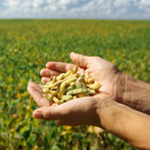For more than 80 years, Daniel Berdini's family has "devoted ourselves to agriculture, beginning with my grandfather, then my father and now me." Berdini's family farm grows various crops in Villa Ramallo in the northern part of Argentina’s Buenos Aires province. He is among the farmers hoping for positive change to come from the opening of dialogue between The Inter-Cooperative Agricultural Confederation (Coninagro), which represents cooperatives ofsmall and midsize agricultural producers in Argentina, and recently reelected Argentine President Cristina Fernandez de Kirchner.
For the past three years, Coninagro, along with the Argentine Rural Society,the Argentine Agrarian Federation and the Argentine Rural Confederation, have comprised an umbrella organization known as the Liaison Table. The group gained widespread attention in 2008 for defending the interests of agricultural producers afterthe government imposed of new taxes on agricultural exports of products including cereals and oil seeds.
On March 11, 2008, Argentina's economy minister, Martin Lousteau,introduced a plan that raised taxes on agricultural exports from a fixed 35% to 44%, whichfluctuated along with international prices on various commodities, such as soybeans, wheat and corn.Argentine farm groups responded angrily by blocking roads and banging on pots, and food shortages also followed. Ultimately, the 101-day-long conflict was resolved in favor of the agricultural sector when Julio Cleto Cobos, then Argentina’s vice president and leader of its Senate, voted against the government’s tax measure.
Nevertheless, almost fouryears after those protests took place, Argentine farmers still suffer from weakcompetitiveness, not only because of the country’s tax on exports, which are as high as35%, but also because of export quotas imposed by commerce secretary Guillermo Moreno. Other negative factors include rising prices onkey inputs such as fuels, an inflation rate of nearly25% and an overall failure to makeimprovements in the country’s deteriorating infrastructure.
But the recent visit by Kirchner to Coninagro could be the beginning of a frank and constructive dialogue between the two parties, according to Alberto Rubio, dean of the graduate school at the University of Belgranoin Argentina. "It could be a path to understanding if the dialogue widens [to include] other members of the so-called Liaison Table."
Fernando Vilella, director of the Agribusiness Program at the department of agronomy at the University of Buenos Aires (UBA), also stresses the importance of the government’s recent "presentation of goals for its Agri-Food and Agribusiness Strategic Plan (known as PEA2), and its Agroindustrial Strategic Plan (PEI) for the agro-industrial heartland of the country." The Ministry of Agriculture launched PEA2 this year with the intention of developing strategies for the future of the sector through 2020, and increasingannual grain production from 100 million tons today to 150 million by 2020. Meanwhile, Kirchner launched the PEI in early October in Venado Tuerto,Argentina’s heartland foragricultural production.
All of these factors may have a favorable impact over the short term, experts say, and help bring reforms toa sector that, according to Coninagro, contributes 36% of the country’s jobs and 54% of its foreign currency revenues. Over the past eight years, the sector has contributed $48 billion dollars to the government through withholding taxes, Coninagro reported.
The Unfinished Agenda
As forthe farmers, Coninagroestimates that between 20% and 25% of them manage large tracts of more than 1,000 hectares. The rest are divided between small and midsize producers with holdings of between 40 to 500 hectares, many of which were inherited by the families of immigrants who arrived in the country over the past century, mostly from Spain and Italy.
According to Rubio, if negotiations with the government do take place over theshort term, the agribusiness sector would like to tackle an agenda that is both “broad and complex." Rubio points out that when it comes to taxes, "there should be the progressive elimination of distortive taxes, such as export duties and check taxes, which lower the incomes of producers” and discourage further investment in technology.
At the moment, Argentine agricultural producers not only have to pay withholding taxes, as dolarge producers, but they must also pay check taxes amounting to 1.6% on debts and bank loans, and taxes on profits, which apply to income and are as high as 35%, according to a sliding scale. All of these charges reduce the amount of money thatproducers receive for their products, experts note, and therefore have an impact on the regional economy, thus reducingthe income of the sector.
Rubio adds that the country should avoid governmental intervention through the imposition of export quotas because with that kind of system, producers are forced to keep their grains and if international prices go lower, they lose their profits. Or, as agricultural producer Berdini notes, “The quotas allow us to produce a certain amount, so a lot of supply is created, as in the case of corn and wheat. But sincedemand is low, the millers freeze their prices and producers cannot negotiate. That way, not only do those who harvest lose out, but so do the women who buy a kilo of flour at the supermarket."
In order to produce the needed change in the quotas, the country will have to wait for a new minister of agriculture to be appointed, Vilella predicts. As for changes in the tax system, he says "that will depend partially on what happens to international grain prices, and if [the government decides] on a new tax plan that is less distortive — especially for small and midsize companies — and whichadds value at the place of origin.”
But Henry Déntice, a professor and researcher at the National University of San Martin(UNSAM), does not expect many changes with respect to these issues "because the economic situation in 2012 in Argentinademands fiscal savings and, in this sense, withholding taxes play an important role." In fact, in an attempt to lower the country’s deficit, Kirchner recently announced subsidy cuts that will save the government about US$4.76 billion.
Berdinisuggests that a distinction needs to be made between the circumstances of Argentina's large producers and that of farmers who work smaller plots of land. "The small farmer who works his family land rents thefields at high prices with sky-high inputs in dollars," he says. "And then along comes a very strong increase in prices forfuels and lubricants, since the price of diesel has risen from 2 pesos to 6 pesos (US$1.5) per liter. Although the small producer has benefited from the tailwinds of high international commodity prices, it is becoming more and more expensive to maintain his family and educate his children because of high inflation, which steadily increases the cost of the family’s basket of goods." Berdini adds that it is difficult to be competitive if your landholdings are small. "It is a problem of scale," he notes. "Those who have large areas of land can negotiate better prices for such inputs as [the herbicide] glyphosate."
Given this situation, Berdini, a consultant for Coninagro, wants the government to look for containment mechanisms "with highly subsidized loans to compete in the purchasing of inputs. You haveto focus as much as possible on cooperative systems to sell grains in a better way." On the other hand, he suggests that the government could establish a system wheremedium and small producers pay different prices for fuel, as well as some sort of card that provides bonuses and benefits that vary accordingto the category of theproducer.
Historical Challenges
In addition to fiscal and regulatory challenges, Argentina faces problems that have been neglected for many years, such as its inadequate infrastructure. Insecurity, routes congested with traffic, a shortage of roads and the low level of rail usage all combine to push up prices for the agricultural sector and make the sector less competitive."You need to implement development through investments that add efficiency and effectiveness to the intermodal transportation system, so you can provide greater competitiveness to all points of production, especially regional economies located far from consumption centers and ports," Rubio says.
Vilella agrees that the country faces a serious infrastructure problem. Although Argentina’s annual grain production is now 100 million tons, "if we reached 150 to 160 million tons by 2010, as [the government has] forecast in the PEA2 [plan], we will need additional warehousing space and better railroads," he notes. "We will need to lower the average age of of our worn-out trucks; improve our ports and the access routes to them; sustain and expand ourwaterways; facilitate our access routes [across the Argentine and Chilean Andes] tothe Pacific Ocean; increase the amount of land under irrigation and bring energy to places where it will add value."
Berdini says it is not by chance that there are so many accidents on Argentine roads. "In addition to the inexperience of drivers, itcan be impossible to get to your destination because of poor maintenance, growth in the volume of vehicles and the condition of the roads on which all grains are transported,” he notes.
Analysts and producers say that Argentina, whose soil and climate are ideal for agriculture, has a huge opportunity to establish itself on the world map as a leading supplier of food. The issue is whether the country will seize that opportunity. "If we can solve our organizational and institutional problems, Argentina will play an important role in the supply of grains and, evenbetter, value-added grains and meats, oils, biofuels and so forth," Vilella states.
Vilella adds that Argentina could — and should — reposition itself as a safe, long-term supplier offoods and renewable energy, such as biodiesel made from grains. "This requires governmental policy that involves monitoring [products in the agricultural supply chain], but without imposing anyintervention in the markets of agro-industrial products," he says.
According to Berdini, Kirchner’s visit to Coninagro was an important step forward, but it remains to be seen what will happen next."From our perspective, those of us who belong to the cooperatives, a lot of teaching has to be done to protect us and help us; but the government also has to do a lot of things," he says. "Every year, we lose about ten thousand farmers because of the lack of any concrete agricultural policy."



